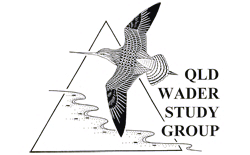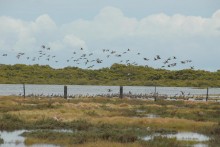Binoculars are one of the first items to be placed in the birding kit bag and 8×40 or 10×50 models are popular choices. The first number refers to the power of magnification and the second, the diameter, in millimetres, of the objective lens. The objective lens is the lens through which light first enters the binoculars. Buying binoculars is a trade-off. Higher magnification binoculars obviously provide a closer view of the bird but are larger, heavier and generally more expensive than their lower magnification counterparts. Weight can become an important consideration after a long day’s walking and vibrations from an unsteady hand are also accentuated at higher magnification. Lower magnification binoculars provide a broader field of view and often, but not always, closer focussing. One last consideration when buying binoculars is the ratio of objective lens diameter to magnification, also called the exit pupil. The greater the ratio, the more light that reaches your eye and the brighter the image is. A ratio of five (e.g. 50/10) is considered optimal, although under all but the dimmest conditions, any ratio above four is adequate, especially in the open spaces of the coast.
Binoculars are often not powerful enough to identify a distant wader. To get the most enjoyment out of wader watching, a quality spotting scope mounted on a tripod is essential. With a spotting scope, you can pick up the length or shape of a bill or other diagnostic features necessary to enable a positive identification. A spotting scope will also let you fully appreciate the subtlety of a bird’s plumage. A sturdy tripod is essential, as vibration from the wind is very noticeable at high magnification.
Eyepieces for most models of spotting scope can be purchased separately from the body of the scope. Eyepieces are either fixed magnification or zoom. Popular choices with a fixed magnification are 15×, 20×, 25× and 30×, some of which are available in wide angle. The most popular zoom eyepieces are 15-40× and 20-60×. Zoom eyepieces give flexibility but with the cheaper brands, a loss in clarity when compared with fixed magnification eyepieces. This loss in clarity is insignificant with more expensive brands. You will find that viewing at very high magnification has its limitations, especially when there is heat haze or it is breezy, causing vibration. With most brands of spotting scope, alternative versions of a particular model are available that have the eyepiece either offset at an angle of 45º or directly in line with the body of the scope. Use of an offset eyepiece does take a little time to get used to but does allow the user to stand up straighter when viewing a bird in a tree and it is easier to sketch from. Furthermore, if use of the scope is shared, a taller person does not need to stoop as much to view through an offset eyepiece.
One last consideration when purchasing a spotting scope is the problem of chromatic aberration. When light passes through a lens, the different wavelengths of light bend at different angles causing the red light to focus on a different plane to that of the blue light. Chromatic aberration results in slightly poorer image quality and a purple fringe around high contrast images. Several strategies are used by the manufacturer to overcome chromatic aberration including application of various coatings such as fluorite to the objective lens and use of low dispersion glass (sometimes referred to as ED glass). Whether the improvement in image quality associated with the use of low dispersion glass merits the significant hike in price of the scope is up to one’s personal judgement.
Before making your purchase, make sure you do lots of research. Birding magazines regularly publish reviews of optical equipment and good information can be found on the Internet. Discuss the various makes and models with other bird watchers and try them out in the field in different conditions. When purchasing, test the equipment through the window of the store and if possible, also outside the store.
After optical equipment, one of the most important items you need is a field guide. There are several good general field guides for Australian birds. Talk to other bird watchers about their favoured field guide. For those wanting a specialist field guide, Shorebirds: an identification guide to the waders of the world, by P. Hayman, J. Marchant and T. Prater, is the most comprehensive, covering every wader species in the world including the different plumages. Out in the field, your chosen field guide will benefit from a plastic covering to protect it from rain and general wear and tear.

